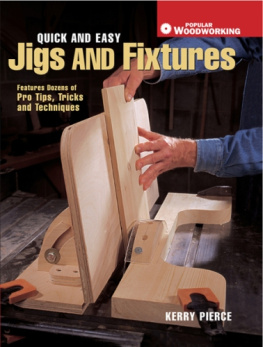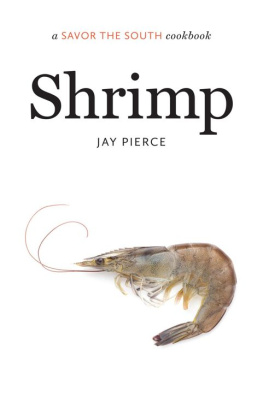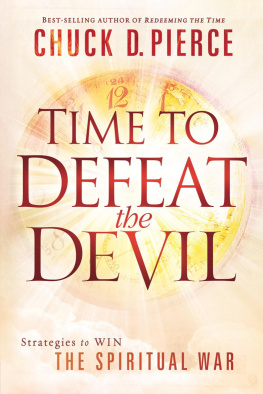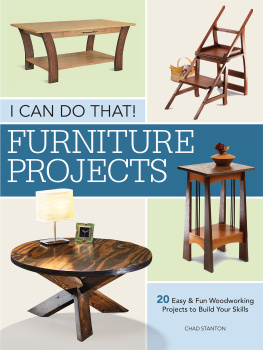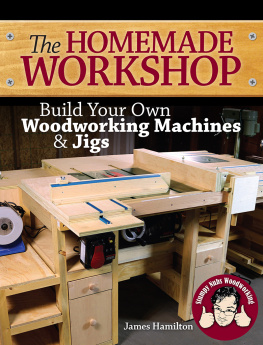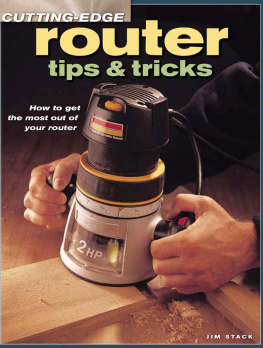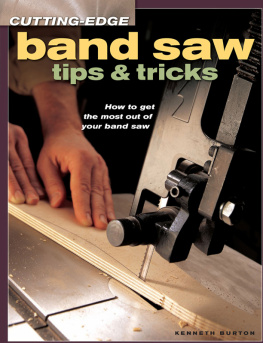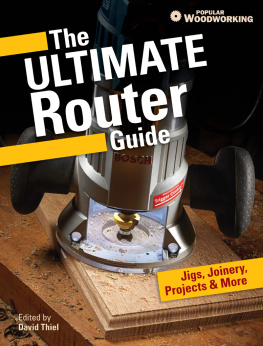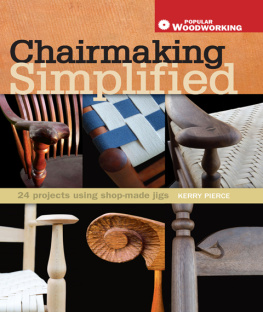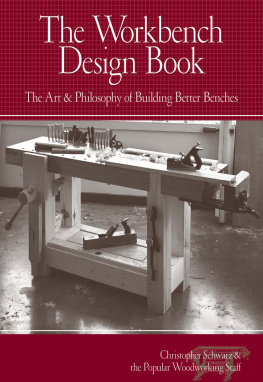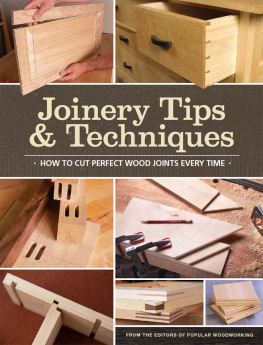
QUICK AND EASY Jigs AND Fixtures
KERRY PIERCE

Quick and Easy Jigs and Fixtures. Copyright 2005 by Kerry Pierce. Printed and bound in China. All rights reserved. No part of this book may be reproduced in any form or by any electronic or mechanical means including information storage and retrieval systems without permission in writing from the publisher, except by a reviewer, who may quote brief passages in a review. Published by Popular Woodworking Books, an imprint of F+W Publications, Inc., 4700 East Galbraith Road, Cincinnati, Ohio, 45236. First edition.
Distributed in Canada by Fraser Direct 100 Armstrong Avenue Georgetown, Ontario L7G 5S4 Canada
Distributed in the U.K. and Europe by David & Charles Brunel House Newton Abbot Devon TQ12 4PU England Tel:(+44) 1626 323200 Fax: (+44) 1626 323319 E-mail: mail@davidandcharles.co.uk
Distributed in Australia by Capricorn Link P.O. Box 704 Windsor, NSW 2756 Australia
Visit our Web site at www.popularwoodworking.com for information on more resources for woodworkers.
Other fine Popular Woodworking Books are available from your local bookstore or direct from the publisher.
09 08 07 06 05 5 4 3 2 1
Library of Congress Cataloging-in-Publication Data
Pierce, Kerry.
Quick and easy jigs and fixtures /Kerry Pierce. 1st ed.
p. cm.
Includes index.
ISBN 1-55870-709-3(pbk.:alk. paper)
ISBN 13: 978-1-55870-927-0 (EPUB)
1. Chairs. 2. Furniture making. I. Title.
TT197.5.C45P56 2005
684.08 dc22
2005000215
ACQUISITIONS EDITOR: Jim Stack
EDITOR:
Amy Hattersley
DESIGNER: Brian Roeth
COVER AND CHAPTER OPENER PHOTOGRAPHY BY: Tim Grondin
PRODUCTION COORDINATOR: Jennifer Wagner
MEASURED DRAWINGS BY: Kevin Pierce


READ THIS IMPORTANT SAFETY NOTICE
To prevent accidents, keep safety in mind while you work. Use the safety guards installed on power equipment; they are for your protection. When working on power equipment, keep fingers away from saw blades, wear safety goggles to prevent injuries from flying wood chips and sawdust, wear headphones to protect your hearing, and consider installing a dust vacuum to reduce the amount of airborne sawdust in your woodshop. Don't wear loose clothing, such as neckties or shirts with loose sleeves, or jewelry, such as rings, necklaces or bracelets, when working on power equipment. Tie back long hair to prevent it from getting caught in your equipment. People who are sensitive to certain chemicals should check the chemical content of any product before using it. The authors and editors who compiled this book have tried to make the contents as accurate and correct as possible. Plans, illustrations, photographs and text have been carefully checked. All instructions, plans and projects should be carefully read, studied and understood before beginning construction. In some photos, power tool guards have been removed to more clearly show the operation being demonstrated. Always use all safety guards and attachments that come with your power tools. Due to the variability of local conditions, construction materials, skill levels, etc., neither the author nor Popular Woodworking Books assumes any responsibility for any accidents, injuries, damages or other losses incurred resulting from the material presented in this book. Prices listed for supplies and equipment were current at the time of publication and are subject to change. Glass shelving should have all edges polished and must be tempered. Untempered glass shelves may shatter and can cause serious bodily injury. Tempered shelves are very strong and if they break will just crumble, minimizing personal injury.
About the Author

For over a quarter century, Kerry Pierce has specialized in post-and-rung chairmaking. He is the author of over ten woodworking books, including The Art of Chair-Making, Making Elegant Gifts from Wood, The Custom Furniture Sourcebook and Authentic Shaker Furniture. Since 1995, he's served as contributing editor of Woodwork and is a frequent contributor to that magazine. His chairs have been exhibited at a number of Ohio venues, most recently at Ohio Furniture by Contemporary Masters at the Ohio Decorative Arts Center. He has also been a chairmaking instructor at the Marc Adams School of Woodworking.
Acknowledgements
In October of 2003, I was diagnosed with Stage 4, non-Hodgkins lymphoma. I was given only a slight chance of surviving the disease. At the time of my diagnosis, I had just begun work on this book, so shortly after I received the bad news, I contacted my editor at Popular Woodworking Books, Jim Stack, and explained I would be unable to finish the book by the June 2004 deadline stipulated in our contract. In fact, I said, I might not be able to finish it at all. Then I put the book aside and concentrated on my illness.
For the next six months, I fought my cancer with a series of intense, five-day-long chemotherapy sessions. The chemo was potent stuff, so potent, in fact, that the nurses who loaded my IV double-gloved their hands before touching the bags in which the toxins were stored.
My response to chemotherapy was better than my doctors had expected, and after six months, my cancer was in remission. The war wasn't over, but I had won the first battle. In March, when my oncologist gave me the green light to return to the shop although on a limited basis I e-mailed Jim Stack to see if they had any work I could do to earn the advance money they'd already paid me for this jig-and-fixture book, money which I'd already spent on medical bills.
He said: Sure. Why not finish the book?
That, I think, says a lot about the kind of people I work for at Popular Woodworking Books. I had assumed that this book had been assigned to someone else during the months I was out of commission. After all, my failure to deliver on time had left a hole in the company's publication schedule. But they didn't give the book to someone else. Instead, they shuffled things around to fill in the gap in their publication schedule and held onto this title until I was ready to go back to work on it.
Maybe it wasn't a smart business decision, but it was the only decision the people at Pop Wood were capable of making.
So thanks, Jim, and everybody else at Pop Wood who had a hand in treating me so well during my illness.
Thanks to John LaVine at Woodwork magazine, who, when he realized I could no longer work in the shop, offered me writing assignments that didn't require me to get dusty.
Thanks also to Roger Mace and Martie Moore who endeavored to keep my shop remodel moving forward when I was on the physically-unable-to-perform list.
Thanks also to Dr. Porcu and the staff at The James Cancer Hospital in Columbus, Ohio, for their gracious handling of a sometimes cranky cancer patient.
And thanks, also, to my wife, Elaine; my daughter, Emily; my son, Andy; my parents Jim and Sally; my brother, Kevin; my friend, Verne; and everybody else who stood with me during a long and difficult year.

